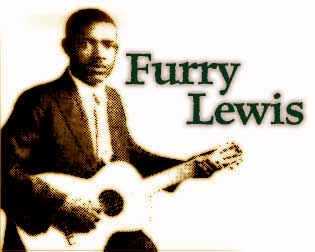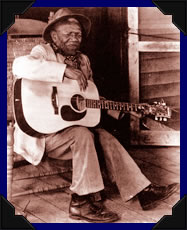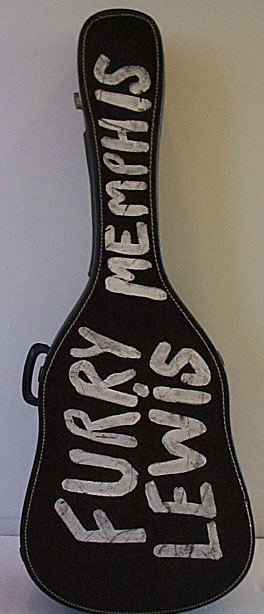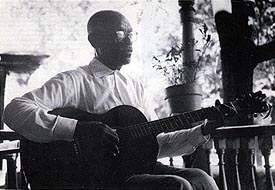
Beale Street, Memphis, Tennessee. Just the name of it raises images of musicians ranging from W.C. Handy to B.B. King. Jug bands playing in the park, smoky Blues clubs and long-gone speakeasies, card houses and brothels. A cultural center for African American life-styles throughout much of the 20th Century, located smack dab in the middle of the Country's most musically fertile region: The Mississippi River Valley. But, perhaps nobody knew Beale Street better than Walter "Furry" Lewis, a Blues musician who's life revolved along the street, with and without his instrument. A man who would encounter fame more than once during his lifetime, and who would became one of Memphis' most-favored musical sons.
His parents, Victoria and Walter Lewis were sharecroppers living in Greenwood, Mississippi. Walter, Jr. never knew or met his father, as the couple separated before the birth of their son on March 6, 1893. Young Walter, along with his mother and two sisters, relocated to Memphis when he was six years old, and his mother began taking in wash, cooking and cleaning homes to make a living. He attended nearby Carnes Avenue School, but only made it to the fifth grade before taking on work himself as a delivery boy to help his family make ends meet.
Furry, as he was called by his childhood friends, developed an interest in music before he reached the age of 10. It was the harmonica that first caught his ear, but he was unable to figure the instrument out. Next he made himself a crude guitar by nailing a 2-x-4 to a cigar box, using screen-door wires for strings. By using more nails at the end, he was able to tune the makeshift instrument and it was with this creation that Lewis taught himself to play. Soon after, he became a regular sight walking along the streets playing for spare change.
 Furry's desire to play soon caught the eye of one of Memphis' most-famed musicians, W.C. Handy. Handy recognized the unleashed talent inside of the youngster and he purchased him his first real guitar, a Martin that Lewis would possess for at least the next 20 years. Handy would also occasionally take on the blossoming guitarist, allowing him to perform with his renowned orchestra.
Furry's desire to play soon caught the eye of one of Memphis' most-famed musicians, W.C. Handy. Handy recognized the unleashed talent inside of the youngster and he purchased him his first real guitar, a Martin that Lewis would possess for at least the next 20 years. Handy would also occasionally take on the blossoming guitarist, allowing him to perform with his renowned orchestra.
The bug for performing struck a chord within Furry and he decided to leave home while still a teenager to work in the traveling medicine shows, a common sight during this time throughout the southern United States. With these troupes, Furry did not begin as a musician, But rather worked as a comedian, sold corn medicine and liniment oils, or did vaudeville sketches, often in blackface. During these travels, he continued to develop his guitar skills and probably learned how to play bottleneck style. He was also exposed to many of the best-known Blues musicians of the time; people such as, Memphis Minnie, Texas Alexander, Blind Lemon Jefferson, and often he would play alongside noted guitarist Jim Jackson.
His guitar work began to pay off for him and he had no problem making money. But, in 1916, he found himself attempting to jump a freight train outside of Du Quoin, Illinois. He didn't need to ride the rails in this manner, as he had about $200 - $300 in his pocket at the time and could've purchased a ticket, but Furry wanted to save the cost and while trying to jump the train, he caught his foot in a coupling and was struck, losing his leg. He spent the next month in a railroad hospital in Carbondale. Illinois, recuperating from the injury. He was later fitted with an artificial leg that took him nearly a year to become comfortable with wearing.
It was too much of a hardship to try to work as an itinerant musician with an artificial leg, so Lewis returned to Memphis. He took up performing on street corners with the local jug bands, often with popular favorites such as Will Shade's Memphis Jug Band and Gus Cannon's Jug Stompers. But, Furry made his living more often doing a variety of odd jobs including freight hauling from riverboats, yard work or delivering groceries. In 1923, he took a position with the Memphis Sanitation Department, sweeping streets around Beale; a job that he would hold for the next 43 years.
In 1927, Furry Lewis made two trips to Chicago alongside his old friend Jim Jackson, with the purpose of cutting records for Vocalion. The sessions produced five sides in April and another six later in October of that year. Over the next two years, a total of 23 sides in all were recorded by Lewis for both the Vocalion and Victor labels and Furry began to receive regional recognition. Among the recordings he created during this period were many that are considered the definitive Blues recordings of such tunes as "Kassie Jones," "Stack-O-Lee," and "John Henry;" as well as signature numbers like "Judge Harsh Blues" and "I Will Turn Your Money Green" (the latter which included the classic line, "Been down so long, it looks like up to me").

But, The Depression hit the country in 1929 and a great deal of recording came to a halt. The 23 sides (the most of any Memphis musician of the period) would be the last recorded by Furry for the next 30 years.
In 1959, music researcher, Samuel Charters, located Furry Lewes in his home near Beale Street. Furry had continued playing alongside the street musicians over the years, but with the newfound craze of Folk and Blues music, the time was right for his "Rediscovery." Two albums worth of material were recorded for the Folkways and Prestige labels, both released in 1961. Titled, "Back On My Feet Again", and "Done Changed My Mind," they showcased Furry's guitar skills that had shown no sign of decline despite a 30-year absence.
Furry became a popular attraction at Folk and Blues Festivals and college campus appearances throughout the 1960s. But, despite this new-found resurgence of fame, he received very little monetary gain and often found himself having to place his guitar in hock to survive day-to-day. But, money was never that important to Furry Lewis; he found his joy in performing.
By 1970, Furry had become a celebrity in yet another musical realm as he found himself playing with some of the era's top Rock musicians. He opened shows for The Rolling Stones, including one before 53,000 in his hometown of Memphis; he toured with Leon Russell, and also as a member of the Alabama State Troupers with Don Nix and Jeanie Greene.
The '70s, continued to be commercially popular for Furry Lewis. In 1970 he was profiled in a featured story in Playboy Magazine, written by Stanley Booth (this was later reprinted in Booth's book "Rhythm Oil"). He took on a role in the Bart Reynolds' film, " W W And The Dixie Kings," and as part of the promotional tour for the movie, Furry appeared on the Tonight Show with Johnny Carson. He performed his song, "Furry's Blues" on the show and gained so much attention he found himself asked to appear on multiple television talk shows throughout the remainder of his life. Perhaps the greatest recognition that he was to receive came in 1973 when he was named as an Honorary Colonel by the State of Tennessee, the first African-American ever to receive that honor.
Not all of the attention was to Furry's liking though. In 1976, Folk-Rock musician, Joni Mitchell recorded the song, "Furry Sings The Blues", for her "Heijera" album. Lewis hated the song and felt that since he was the subject of it, he deserved royalties from Mitchell.
 It is amazing to note that despite Furry's age, he retained his playing dexterity right up to the end of his life. His style incorporated a blend of both slide and fingerpicking, often alternating between both within a single song. His music was rooted in the rags and Delta Blues he heard in his youthful travels, as well as the jug bands of Memphis. And, his lyrics offered visions of social issues, folklore and humor. A true original and innovator, he continued to release vital material until his death, often with liner notes informing buyers that the recordings had been made at his bedside, "with his leg off".
It is amazing to note that despite Furry's age, he retained his playing dexterity right up to the end of his life. His style incorporated a blend of both slide and fingerpicking, often alternating between both within a single song. His music was rooted in the rags and Delta Blues he heard in his youthful travels, as well as the jug bands of Memphis. And, his lyrics offered visions of social issues, folklore and humor. A true original and innovator, he continued to release vital material until his death, often with liner notes informing buyers that the recordings had been made at his bedside, "with his leg off".
He began to lose his eyesight due to cataracts in his final years. He came down with a case of pneumonia in 1981, which led to his death on September 14th of that year at the age of 88. He is buried in the Hollywood Cemetery in South Memphis, where his grave bears two headstones. A large one, purchased by fans, towers over the original marker that bears simply the epitaph "Bluesman". It does not need to say anything more.
By: Greg Johnson
Article Reprint from the July 2001 BluesNotes